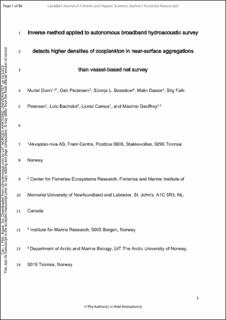| dc.contributor.author | Dunn, Muriel Barbara | |
| dc.contributor.author | Pedersen, Geir | |
| dc.contributor.author | Basedow, Sünnje Linnéa | |
| dc.contributor.author | Daase, Malin | |
| dc.contributor.author | Falk-Petersen, Stig | |
| dc.contributor.author | Bachelot, Loic | |
| dc.contributor.author | Camus, Lionel | |
| dc.contributor.author | Geoffroy, Maxime | |
| dc.date.accessioned | 2023-01-17T11:10:42Z | |
| dc.date.available | 2023-01-17T11:10:42Z | |
| dc.date.created | 2023-01-10T13:14:07Z | |
| dc.date.issued | 2022 | |
| dc.identifier.issn | 0706-652X | |
| dc.identifier.uri | https://hdl.handle.net/11250/3043956 | |
| dc.description.abstract | Throughout all oceans, aggregations of zooplankton and ichthyoplankton appear as horizontal sound scattering layers (SSLs) when detected with active acoustic techniques. Quantifying the composition and density of these layers is prone to sampling biases. We conducted a net and trawl survey of the epipelagic fauna in northern Norway (70˚N) in June 2018 while an autonomous surface vehicle equipped with a broadband echosounder (283-383 kHz) surveyed the same region. Densities from the autonomous hydroacoustic survey were calculated using forward estimates from the relative density from the net and trawl, and inversion estimates with statistical data-fitting. All four methods (net, trawl, acoustic forward and inverse methods) identified that copepods dominated the epipelagic SSL, while pteropods, amphipods and fish larvae were present in low densities. The density estimates calculated with the inverse method were higher for mobile zooplankton, such as euphausiid larvae, than with the other methods. We concluded that the inverse method applied to broadband autonomous acoustic surveys can improve density estimates of epipelagic organisms by diminishing avoidance biases and increasing the spatio-temporal resolution of ship-based surveys. | en_US |
| dc.language.iso | eng | en_US |
| dc.title | Inverse method applied to autonomous broadband hydroacoustic survey detects higher densities of zooplankton in near-surface aggregations than vessel-based net survey | en_US |
| dc.title.alternative | Inverse method applied to autonomous broadband hydroacoustic survey detects higher densities of zooplankton in near-surface aggregations than vessel-based net survey | en_US |
| dc.type | Peer reviewed | en_US |
| dc.type | Journal article | en_US |
| dc.description.version | acceptedVersion | en_US |
| dc.source.journal | Canadian Journal of Fisheries and Aquatic Sciences | en_US |
| dc.identifier.doi | 10.1139/cjfas-2022-0105 | |
| dc.identifier.cristin | 2104127 | |
| dc.relation.project | Norges forskningsråd: 269188 | en_US |
| dc.relation.project | Norges forskningsråd: 287043 | en_US |
| dc.relation.project | Norges forskningsråd: 309512 | en_US |
| cristin.ispublished | true | |
| cristin.fulltext | postprint | |
| cristin.qualitycode | 2 | |
